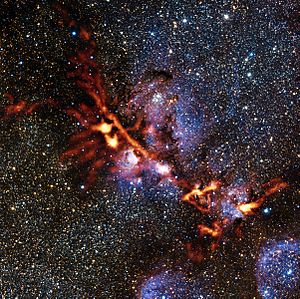NGC 6334 facts for kids
NGC 6334 is a giant cloud of gas and dust in space where new stars are being born. It's called an emission nebula because it glows brightly, giving off its own light. This amazing cosmic cloud is found in the constellation of Scorpius, which is a group of stars that look like a scorpion in the night sky.
NGC 6334 is incredibly far away from Earth – about 5,500 light-years! To give you an idea, one light-year is the distance light travels in one year, which is about 9.5 trillion kilometers (6 trillion miles). So, 5,500 light-years is a truly vast distance!
Contents
What is a Nebula?
A nebula is a huge cloud of gas and dust in space. The word "nebula" comes from a Latin word meaning "cloud." Nebulae are often where stars are born, or they can be the remains of stars that have exploded.
Types of Nebulae
There are different kinds of nebulae:
- Emission Nebulae: These nebulae glow because the gas inside them is heated by nearby hot, young stars. The stars give off a lot of ultraviolet light, which makes the gas atoms glow, much like a neon sign. NGC 6334 is an emission nebula.
- Reflection Nebulae: These nebulae don't glow on their own. Instead, they reflect light from nearby stars, like fog reflecting car headlights.
- Dark Nebulae: These are dense clouds of dust that block light from behind them, making them appear dark against brighter backgrounds.
- Planetary Nebulae: These are not related to planets! They are the shells of gas thrown off by dying stars, usually white dwarfs.
- Supernova Remnants: These are the expanding clouds of gas and dust left behind after a massive star explodes as a supernova.
Star Formation in NGC 6334
NGC 6334 is a very active place for star birth. Inside this nebula, gravity pulls together clumps of gas and dust. As these clumps get bigger and denser, they start to heat up. Eventually, the core of a clump becomes hot and dense enough for nuclear fusion to begin, and a new star is born!
How Stars Are Born
The process of star formation in nebulae like NGC 6334 happens in several steps:
- Cloud Collapse: A large cloud of gas and dust starts to collapse under its own gravity.
- Protostar Formation: As the cloud collapses, it spins faster and flattens into a disk. A dense, hot core forms in the center, called a protostar.
- Nuclear Fusion: The protostar continues to gather more material and heat up. When its core reaches about 15 million degrees Celsius, nuclear fusion begins. This is when hydrogen atoms combine to form helium, releasing huge amounts of energy.
- Main Sequence Star: Once fusion starts, the protostar becomes a true star, like our Sun. It then enters a long, stable phase called the main sequence.
NGC 6334 is home to many young, massive stars that are still forming or have just recently formed. These powerful stars light up the surrounding gas, making the nebula glow in beautiful colors.
Location and Discovery
NGC 6334 is located in the southern part of the constellation of Scorpius. This constellation is best seen in the summer sky from the Northern Hemisphere and is a prominent feature in the Southern Hemisphere.
Who Discovered NGC 6334?
This incredible nebula was discovered by the famous astronomer John Herschel in 1837. John Herschel was a British astronomer who made many important discoveries and observations of the night sky. He cataloged many nebulae and star clusters, helping us understand more about our universe.
Images for kids
See also
 In Spanish: NGC 6334 para niños
In Spanish: NGC 6334 para niños



